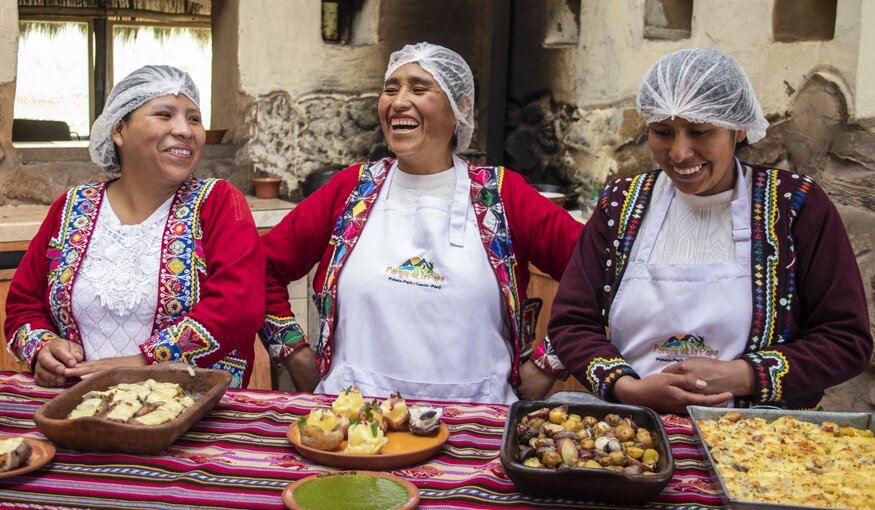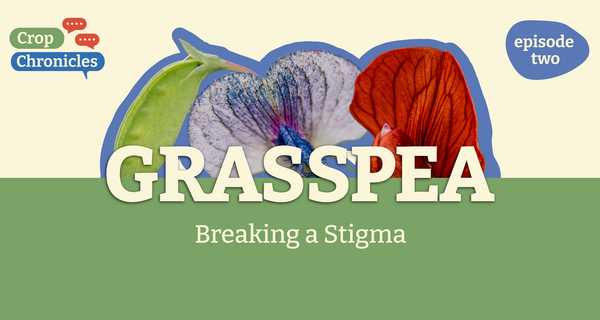The One That Makes the Daughter-In-Law Cry and Other Potato Recipes From the Women of the Potato Park

30 May 2024
Is there a food that’s more emblematic of Peru than the potato? Long, round, bumpy, yellow, purple, red. Every imaginable shape and color is on the menu. And the women there know how to prepare them.
I have been in Peru doing participatory action research at Peru's Potato Park, a unique 15,000-ha reserve high in the Andes that conserves the region's potato biodiversity.
I've worked with the local communities of the Park to help them preserve and showcase the breadth of their biocultural knowledge through video and photography, with a special focus on women's cultural knowledge.
After working there for the last six months, it became really obvious to me how crop diversity is vital for safeguarding food security, both locally and globally. And because it is local culture that maintains the potato biodiversity we see here in the Potato Park, it is really important to value that culture, preserve local knowledge and make sure it is passed down from one generation to the next.
I interviewed five culinary experts – Jovana Sutta Huaman, Antonia Huaman Sutta, Carmen Rosa Palomino, Luz Mila Huaman Sutta, and Gumercinda Sutta de Guerra – about the special place that the potato holds in the community’s cuisine and heart. They belong to the Q’achun Wakachi gastronomy group, a collective of local women in the Potato Park united by their passion for potatoes and other culinary delights.
Sarah: What does potato diversity mean to you?
Women of Q’achun Wakachi: It’s the glue that holds our community together. Across all the families in the Potato Park, with the support of the Potato Guardians, we have a living collection of more than a thousand varieties of potatoes.
There are many varieties because of our culture: we live as a community. We share all the potatoes we have grown and passed down from one generation to the next with our wider family members and neighbours, and they share theirs with us.
In the end, each family has hundreds of varieties of potato, and it helps to keep potato diversity alive. We save the different varieties each year, share them and plant them.
The spirit of the potato is important. If people don’t take good care of the potato, the potato spirit leaves. This is why we have ceremonies to celebrate the potato, and make sure the potato knows that we value and care for it.
The many varieties of potato we have are really important for us, because we also use potatoes for our health. Different potatoes can help us against diabetes, cancer and anemia, because they are full of nutrients.
Sarah: Take us behind the scenes of how you cook these tubers.
Women of Q’achun Wakachi: We use a lot of different recipes to cook the potatoes that we grow. For special occasions like birthdays or weddings, or when there are visitors to the Potato Park, we cook something more complicated like causa tricolor. Today we are using three different potatoes for this recipe: puma lunto, wayro and pacocha senqa. Dulce de papa is another favourite recipe, we normally use camotillo for that.
We even use potatoes to make an alcoholic drink for visitors, a Papa Sour, a twist on the famous Peruvian drink Pisco Sour.
We eat a lot of potatoes with every meal, 15 or 20 a day probably. We eat them in soups, but we also have potatoes that we can cook and take with us to the field, like chuño and moraya. These are made from leaving the harvested potatoes exposed overnight in the coldest months, like June. Because of the altitude and time of year, they freeze in the cold nights, and we walk on them with our bare feet to squeeze out the moisture. This freeze-drying process makes them last for a long time, up to 30 years. To cook them we steam them on the stove and then eat them.
Freeze-dried potatoes are both nutritious and delicious, they make you strong, and because of how we preserve them they are available year round. Every house has chuño for this reason. Also moraya cooks quickly, in about 3 to 5 minutes, so these are like Andean fast food for us.
Recipe: Causa Tricolor

Ingredients:
- 1 kg boiled potatoes
- Lemon juice
- 100 g yellow chilli paste
- 300 g chicken breast, shredded
- 80 g mayonnaise
- 1 avocado, sliced
- 100 ml vegetable oil
- Salt and pepper to taste
How to make causa tricolor?
- Press the potatoes, add the oil, chilli paste, salt, pepper, lemon juice and mix well.
- Divide the mix into three portions (or, if using three different potato varieties, just keep them separate when adding in the seasonings in step 1.
- Using a cup or small bowl, shape the 'causa' potato mix into a circle, and place this first round on the plate as your base.
- Top with shredded chicken, mayonnaise and avocado slices, then add another round of 'causa' potato mix on top.
- Repeat with chicken, mayonnaise and avocado, and top with the final round of 'causa' mix before decorating with a slice of boiled egg, olive, or fresh herbs.
Sarah: Do you have a favorite potato?
Women of Q’achun Wakachi: A favourite potato for the whole gastronomy group is q’achun wakachi: the one that makes the daughter-in-law cry.
It is a potato that has a strong link to women: if you fall in love with a man you have to be able to peel it, or you can’t live with him. It is used in wedding ceremonies, as a kind of test. The bride has to peel the potato without wasting any of it to show that you won’t be wasteful with food (and likely other things), thus making you a good partner. It is really hard to do, because of the bumpy shape of the potato. That’s where its name comes from, and it’s the name we gave to our gastronomy group.
Recipe: Dulce de Papa

Ingredients:
- 500g peeled potatoes
- 500ml milk
- 150g sugar/panela
- Cinnamon to taste
- Cloves to taste
- Pampa anis
How to make dulce de papa?
- Boil the potatoes in water until soft.
- Add cinnamon and cloves to taste.
- Put the potatoes into a mixer, add sugar to taste, then finally add milk.
- Return to the pan and continuously stir until thickened.
- Leave to cool.
*Photos and video courtesy of the author, Sarah Oakes, Postgraduate Researcher and Communications Expert, Asociación Andes and University of Leeds.
Categories: For Educators, For The Press, For Partners, Potato, Nutritional Security



